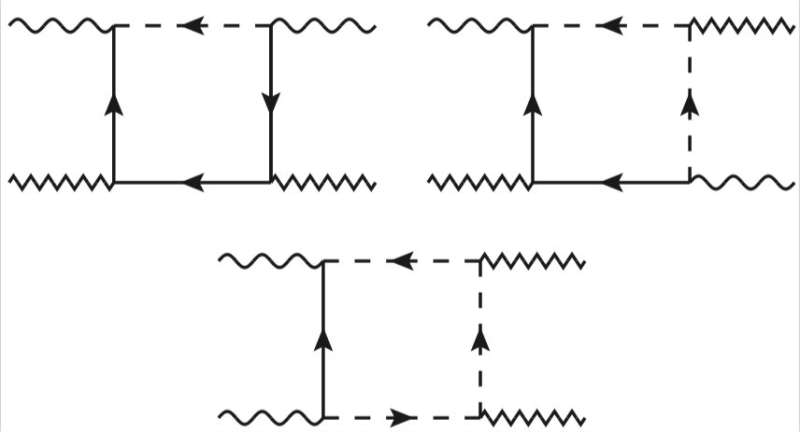July 1, 2019 feature
Study unveils new supersymmetry anomalies in superconformal quantum field theories

Researchers at the University of Southampton and the Korea Institute for Advanced Study have recently showed that supersymmetry is anomalous in N=1 superconformal quantum field theories (SCFTs) with an anomalous R symmetry. The anomaly described in their paper, published in Physical Review Letters, was previously observed in holographic SCFTs at strong coupling, yet their work confirms that it is already present in the simplest free STFCs.
"Supersymmetry is a symmetry that relates particles with integer and half-integer spin, and has played a central role in many advances in theoretical physics since its discovery," Kostas Skenderis, one of the researchers who carried out the study, told Phys.org. "It has been used as a means to understand the behavior of strongly interacting quantum systems where our usual theoretical tools (perturbation theory) are not applicable, as well as in some of the main candidates for beyond the Standard Model physics."
Supersymmetry underlies the mathematical consistency of string theory, which is the most complete theory of quantum gravity proposed so far. A quantum anomaly, such as that observed by the researchers, is essentially the failure of a symmetry to be preserved at a quantum level. These anomalies typically come in two types: "bad" ones, which render string theory mathematically inconsistent and "healthy" ones, which capture important quantum properties of the theory.
"The possibility of anomalies in supersymmetry was discussed in the late '70s to early '90s, but in previous cases, the theories that had a supersymmetry anomaly either had unphysical properties or were 'sick,' because they were inflicted by other 'bad' quantum anomalies," Skenderis said. "It was thus a big surprise when one of us discovered a new supersymmetry anomaly two years ago, this time in a 'healthy' theory."
The previous study carried out by Ioannis Papadimitriou, one of Skenderis' colleagues, inspired the researchers to further explore supersymmetry anomalies in SCFTs. In his previous work, Papadimitriou drew inspiration from earlier studies that used different techniques to compute the same physical observables and obtained conflicting results. The anomaly demonstrated in his work ultimately explained the inconsistencies observed in previous studies.
"The main objective for our recent PRL article was to establish the existence of the new anomaly using the same methods that led to the discovery of quantum anomalies 50 years ago in a simple example of a consistent N=1 superconformal field theory in four dimensions," Papadimitriou explained. "The existence of the new supersymmetry anomaly for any consistent N=1 superconformal theory in four dimensions was demonstrated in previous work and was subsequently shown to exist in a far more general class of theories that are not necessarily classically conformally invariant in."
In their study, Papadimitriou, Skenderis, and their colleagues Georgios Katsianis and Marika Taylor employed the same methods used to discover quantum anomalies in the late '60s. They computed a certain quantum observable (four-point function of symmetry currents), which should be zero if there is no anomaly. Interestingly, however, they found it to be non-zero.
"This computation was done using the simplest possible theory (actually, the first four-dimensional supersymmetric model) and this demonstrated that the anomaly already appears in models developed a long time ago," Skenderis said. "The main novelty here was that the quantum observable we computed was different than the observables investigated in earlier works on supersymmetric anomalies."
The general form of the supersymmetry anomaly demonstrated by the researchers was first presented in a previous study by Papadimitriou that employed the so called Wess-Zumino consistency conditions. These conditions are a set of equations that must hold in order for quantum anomalies to be mathematically consistent.
"Our most important observation was that a very broad class of supersymmetric quantum field theories in four dimensions possess a certain type of supersymmetry anomaly," Skenderis said. "This anomaly has potential implications for a large number of theoretical models for beyond the standard model physics, several of which are likely to be mathematically inconsistent at the quantum level as a result of the new supersymmetry anomaly."
In addition to its theoretical implications, the anomaly observed by Skenderis, Papadimitriou and their colleagues could play a key role in the microscopic understanding of particular black holes that arise in string theory. Ultimately, a better understanding of anomalies within string theory could provide a highly non trivial test of the mathematical consistency of the theory itself. In their future work, the researchers are thus planning to investigate these anomalies further.
"Further generalisation of the supersymmetry anomaly to either lower or higher dimensional theories is a necessary step in order to fully explore the consequences of such anomalies in different contexts," Papadimitriou said. "Moreover, identifying different but equivalent formulations of the supersymmetry anomaly is also helpful in order better understand the implications of the anomaly, both for beyond the standard model physics and for supersymmetric black holes. These are some of the research directions some of us are currently pursuing."
More information: Georgios Katsianis et al. Anomalous Supersymmetry, Physical Review Letters (2019). DOI: 10.1103/PhysRevLett.122.231602
Supercurrent anomalies in 4d SCFTs. arXiv:1703.04299 [hep-th]. arxiv.org/abs/1703.04299
Supersymmetry anomalies in N=1 conformal supergravity. arXiv:1902.06717 [hep-th]. arxiv.org/abs/1902.06717
Supersymmetry anomalies in new minimal supergravity. arXiv:1904.00347 [hep-th]. arxiv.org/abs/1904.00347
The geometry of supersymmetric partition functions. arXiv:1309.5876 [hep-th]. arxiv.org/abs/1309.5876
From rigid supersymmetry to twisted holomorphic theories. arXiv:1407.2598 [hep-th]. arxiv.org/abs/1407.2598
Holographic renormalization and supersymmetry. arXiv:1612.06761 [hep-th]. arxiv.org/abs/1612.06761
Journal information: Physical Review Letters
© 2019 Science X Network





















